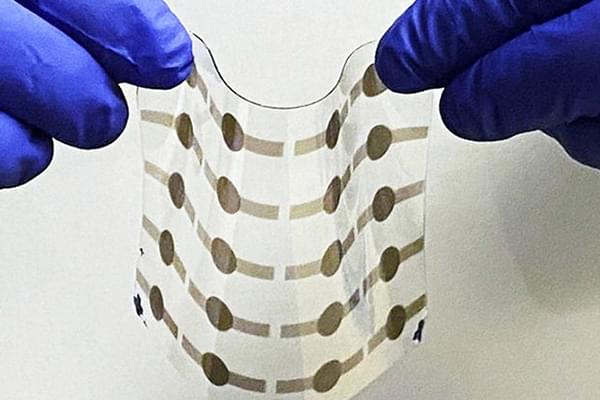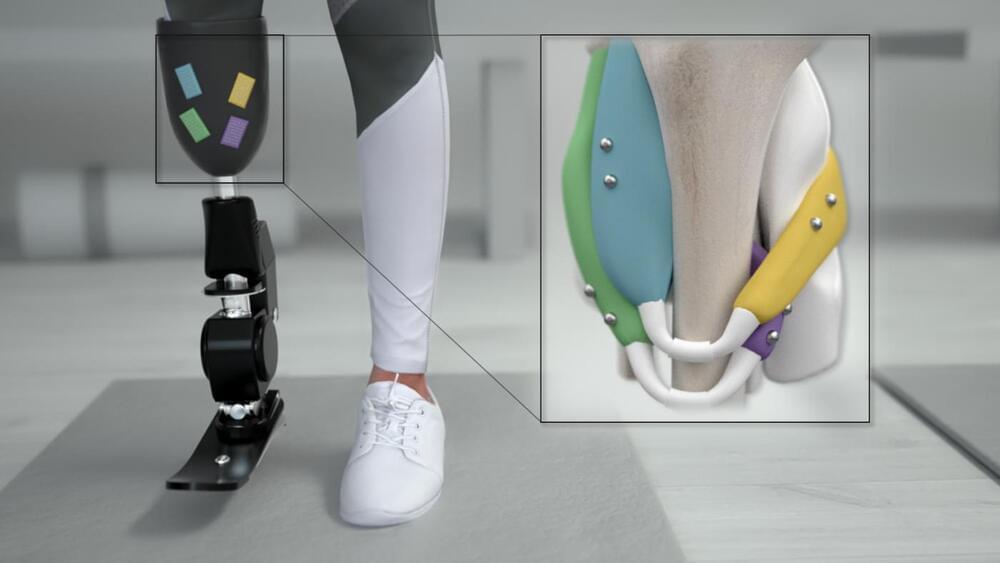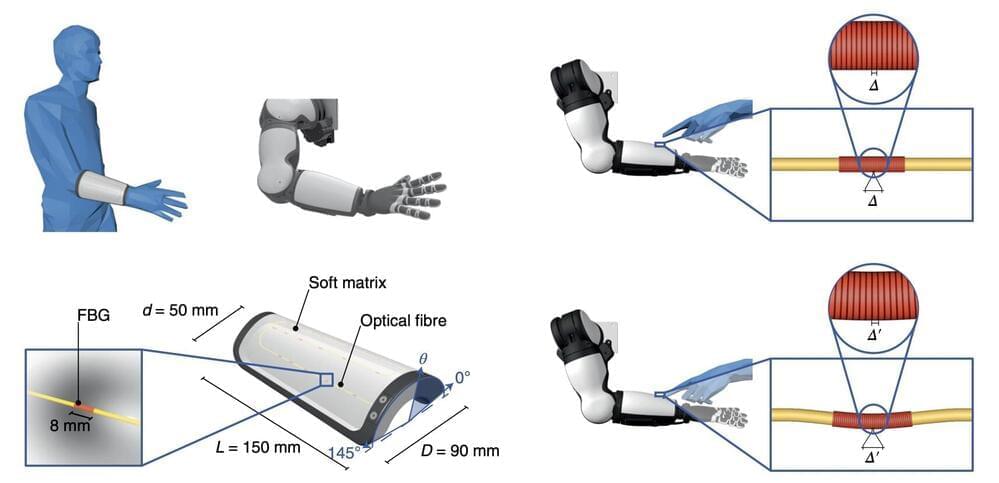Hard yet flexible, chitin builds insects’ exoskeletons, wings, and scales.


Engineers have developed a new class of smart textiles that can shape-shift and turn a two-dimensional material into 3D structures.
The team from UNSW Sydney’s Graduate School of Biomedical Engineering, and Tyree Foundation Institute of Health Engineering (Tyree iHealthE), led by Dr. Thanh Nho Do, have produced a material which is constructed from tiny soft artificial “muscles”—which are long silicon tubes filled with fluid which are manipulated to move via hydraulics.
These artificial muscles, which are surrounded by a helical coil of traditional fibers, can be programmed to contract or expand into a variety of shapes depending on its initial structure.
Brain-machine interfaces (BMIs) are devices that enable direct communication/translation between biological neuronal networks (e.g. a brain or a spine) and external machines. They are currently being used as a tool for fundamental neuroscience research and also for treating neurological disorders and for manipulating neuro-prosthetic devices. As remarkable as today’s BMIs are, however, the next generation BMIs will require new hardware and software with improved resolution and specificity in order to precisely monitor and control the activities of complex neuronal networks. In this talk, I will describe my group’s effort to develop new neuroelectronic devices enabled by silicon nanotechnology that can serve as high-precision, highly multiplexed interface to neuronal networks. I will then describe the promises, as well as potential pitfalls, of next generation BMIs. Hongkun Park is a Professor of Chemistry and Chemical Biology and a Professor of Physics at Harvard University. He is also an Institute Member of the Broad Institute of Harvard and MIT and a member of the Harvard Center for Brain Science and Harvard Quantum Optics Center. He serves as an associate editor of Nano Letters. His research interests lie in exploring solid-state photonic, optoelectronic, and plasmonic devices for quantum information processing as well as developing new nano-and microelectronic interfaces for living cells, cell networks, and organisms. Awards and honors that he received include the Ho-Am Foundation Prize in Science, NIH Director’s Pioneer Award, and the US Vannevar Bush Faculty Fellowship, the David and Lucile Packard Foundation Fellowship for Science and Engineering, the Alfred P. Sloan Research Fellowship, and the Camille Dreyfus Teacher-Scholar Award. This talk was given at a TEDx event using the TED conference format but independently organized by a local community.

Krishna Shenoy helps to restore lost function for disabled patients by designing prosthetic devices that can translate neural brain activity.
Krishna Shenoy directs the Neural Prosthetic Systems Lab, where his group conducts neuroscience and neuro-engineering research to better understand how the brain controls movement and to design medical systems to assist those with movement disabilities. Shenoy also co-directs the Neural Prosthetics Translational Lab, which uses these advances to help people with severe motor disabilities. Shenoy received his bachelor’s degree in electrical engineering from UC-Irvine and his master’s and doctoral degrees in the same field from MIT. He was a neurobiology postdoctoral fellow at Caltech in Pasadena and then joined Stanford University, where he is a professor of electrical engineering, bioengineering and neurobiology.

“We are starting to help patients in ways that we did not think were possible,” Thomas Oxley (Mount Sinai Hospital, New York, USA) tells NeuroNews, referring to the potential of brain-computer interface (BCI) technology. Alongside his role as a vascular and interventional neurologist, Oxley is chief executive officer of Synchron, developer of the Stentrode motor neuroprosthesis. The Stentrode is an implantable BCI device that, according to Oxley, is the first of its kind to be in the early feasibility clinical stage in the USA following US Food and Drug Administration (FDA) approval of Synchron’s investigational device exemption (IDE) application last month. Speaking to NeuroNewsfollowing a presentation on the topic at the Society of NeuroInterventional Surgery’s 18thannual meeting (SNIS; 26–29 July 2021, Colorado Springs, USA and virtual), Oxley gives an overview of the COMMAND early feasibility study, anticipates key results, and considers more generally how BCI technology could shape the future of deep brain stimulation.
In the future, a woman with a spinal cord injury could make a full recovery; a baby with a weak heart could pump his own blood. How close are we today to the bold promise of bionics—and could this technology be used to improve normal human functions, as well as to repair us? Join Bill Blakemore, John Donoghue, Jennifer French, Joseph J. Fins, and P. Hunter Peckham at “Better, Stronger, Faster,” part of the Big Ideas Series, as they explore the unfolding future of embedded technology.
This program is part of the Big Ideas Series, made possible with support from the John Templeton Foundation.
Visit our Website: http://www.worldsciencefestival.com/
Like us on Facebook: https://www.facebook.com/worldscience… us on twitter: https://twitter.com/WorldSciFest Original Program date: May 31, 2014 Host: Bill Blakemore Participants: John Donoghue, Jennifer French, Joseph J. Fins, P. Hunter Peckham Re-engineering the anatomy of the “Vitruvian Man” 00:00 Bill Blakemore’s Introduction. 2:06 Participant introductions. 4:27 What is FES? (Functional Electrical Stimulation) 6:06 A demonstration with FES and without. 10:06 How did you test FES systems? 14:16 Jen French the first bionic pioneer. 16:40 What was the journey like from injury to today? 18:35 A live demonstration of FES. 20:40 What is BrainGate? 27:55 What is the potential for this technology? 37:00 When will this technology be publicly available? 40:50 A cell phone app to drink water or stand up? 44:55 Jen French would be the first to try new technology. 50:39 What is the history of altering the human brain? 1:00:57 The move from chemical to electrical medical care. 1:05:40 The challenge of what is going to drive the delivery of care to groups in need. 1:11:36 Can these devices be implanted without surgery? 1:18:13 What field needs the most funding for this to become available to everyone? 1:19:40 What are the numbers of people who can use this technology? 1:23:44 Why can’t we use stem cells to reconnect human spinal tissue? 1:25:37 What is the collaboration level between institutions? 1:29:16 How far away are we from using brain waves to control objects and communicate with each other? 1:30:20
Follow us on twitter: https://twitter.com/WorldSciFest.
Original Program date: May 31, 2014
Host: Bill Blakemore.
Participants: John Donoghue, Jennifer French, Joseph J. Fins, P. Hunter Peckham.
Re-engineering the anatomy of the “Vitruvian Man” 00:00.
Bill Blakemore’s Introduction. 2:06

Mobile robots are now being introduced into a wide variety of real-world settings, including public spaces, home environments, health care facilities and offices. Many of these robots are specifically designed to interact and collaborate with humans, helping them to complete hands-on physical tasks.
To improve the performance of mobile robots on interactive and manual tasks, roboticists will need to ensure that they can effectively sense stimuli in their environment. In recent years, many engineers and material scientists have thus been trying to develop systems that can artificially replicate biological sensory processes.
Researchers at Scuola Superiore Sant’Anna, Ca’ Foscari University of Venice, Sapienza University of Rome and other institutes in Italy have recently used an artificial skin and a deep learning technique that could be used to improve the tactile capabilities of both existing and newly developed robots to replicate the function of the so-called Ruffini receptors. Their approach, introduced in a paper published in Nature Machine Intelligence, replicates the function of a class of cells located on the human superficial dermis (i.e., subcutaneous skin tissue), known as Ruffini receptors.